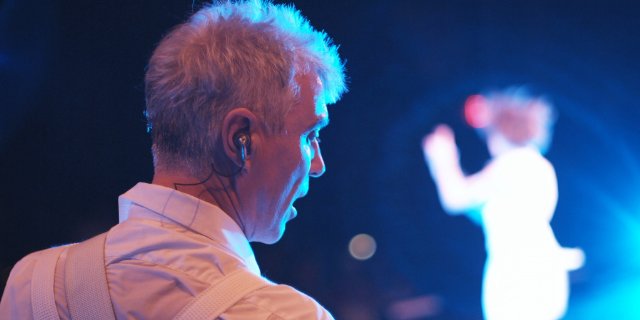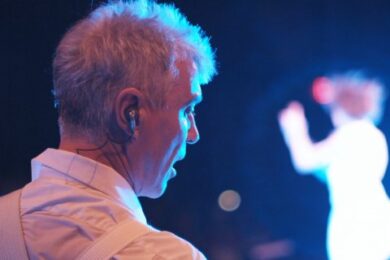As a cultural polymath, David Byrne has been known to adopt many guises, most famously as one of pop’s most leftfield frontmen with Talking Heads. But beyond his musical talents, Byrne has made films (True Stories, 1986, Îlé Aiyé, 1989), worked as an artist (maybe the first to use Microsoft’s PowerPoint as his medium), kept a hugely popular blog, and written books, the most recent of which, Bicycle Diaries 2009, contains his musings on travel, culture, politics and the pleasure of riding on two wheels.
Parting a pair of curtains to enter the dazzling white hotel room in which the interview with David Byrne was to take place, I felt like I was in a Lynchian episode of Blind Date. This uncanny sense grew as I sat down to find a framed painting screwed to the ceiling above. I looked up, catching his eye. “They don’t put paintings on the wall in this place, only on the ceilings”, he said with a wry smile.
Byrne has a gentle but enthusiastic demeanor. His love for his work is apparent, and his energetic performance in Ride, Rise, Roar (2010) – a behind-the-scenes documentary of his 2008/9 tour Whatever Happens Will Happen Today – goes to prove that age is no hindrance. In MRide, Rise, Roar, director David Hillman Curtis explores the creative process behind Byrne and Brian Eno’s first collaborative album since My Life In the Bush of Ghosts (1981), this time partnering their musical mind maps with unorthodox dance… and spinny chairs.
Shot with multiple cameras over several concerts, Curtis captures the dynamism of the auditions, rehearsals and live performances of both Byrne and his team of dancers, whose choreography channels a combination of avant-garde mime and child-like hedonism. This footage is set alongside interviews with Byrne and Eno, who discuss the evolution of their music, giving insight into the workings of their long-distance creative partnership.
Unfortunately, the film doesn’t take the fabulous strides seen in Byrne’s earlier concert doc, Stop Making Sense (dir. Jonathan Demme,1984), where music, costume and set design meet to make extraordinary art. But this is a different stage in Byrne’s career, and he’s created an ensemble piece that delights in its playfulness. Whilst it doesn’t mark the kind of radical departure in concert-documentary-filmmaking that SMS did, it does suggest that David Byrne has no plans to dilute his distinct brand of experimentation anytime soon.
I wonder if you could start by telling me about how you came to meet the director and who’s idea it was to film the creative process.
David Byrne: Director Hillman Curtis was introduced by a mutual friend, Stephen Sagmeister, a designer who Hilman had done a web video portrait of. He had also done some of various artists and other kinds of creative folk, and they were really nice – little short, 10 min maybe, films,and he said “I’d like to do one of you” and I said “Well I’m just finishing up a record with Brian Eno and maybe you’d like to see us wrapping up that project and focusing on that, as opposed to something else I’d done.”
So it started with that and I was getting into the process of auditioning and rehearsing and preparing for this tour and told him ‘you know you’re welcome if you want to come and see that – if you want to shoot any of that process, if you want to be there for, y’know, whatever.’ There was no plan to make a film out of it, but it kind of grew and at some point he and his producer said ‘we want to shoot some of the live shows, when we get it going.’
And they did, but it wasn’t very good, [shakes head gravely] the shows were still in the process of coming together, and the shooting of a live show was not something [Hillman and his producer] were used to and so that was kind of a work in progress as well. But it seemed like maybe there was going to be something there because they already had all this material of the preparation and if they just had some good concert stuff which showed the result of all that, there might be something… It took about a year to get (not a solid year) of trying a few times and then it seemed like they had enough to put something together.
Did you imagine it to have a theatrical release or was it always a side project to the release of the album?
DB: I had no idea it would have a theatrical release that’s really flattering and surprising to me, I though ‘oh it might be direct to DVD or direct to web or who knows?’ But the resolution quality of the video and the audio and that stuff, well its ‘up there’ so if they want to show it on the big screen that’s fine. So it was a pleasant surprise when the offer came to put it in some cinemas.
Dance plays a huge role in the film and I wondered how that came about and how you chose the dance choreographers to choreograph the whole thing
DB: I wanted to have a visual element in the show; other people had done big video screens and things like that (probably better than I could) so I have to come up with something and I thought ‘oh, I’ll have dancers’ so I approached three different choreographers and said ‘here’s the set list, pick two and start with that’. I went to choreographers whose work I’d seen: Annie-B Parson has this Big Dance Theatre and I’d seen her work and she’d worked with musicians before. Noémie Lafrance had done a Feist video which was widely seen and also had used non-trained dancers and lots of site specific things like a piece in an empty swimming pool or a piece in an office stairway so that for me was good. The other was Robinson Childs I had never seen them do anything live but I seen a video they did in an art gallery that was really just the two of them performing in different locations dressed in matching outfits [chuckles to himself] and doing these kinda synchronised movements and kinda funny and very ordinary.
Noémie Lafrance – Feist, ‘1, 2, 3, 4.’
I saw the tour twice and I really enjoyed the dancing and I really don’t think of myself as someone who likes dance. I think the reason I liked it was because it was quite weird and quite funny and very everyday gestures which ties in really well with the album, the title of which expresses both optimism and a sense of dread [Byrne nods in agreement] I was wondering how you worked with the dancers to kind of solidify all these ideas and really make this performance work as a whole.
DB: OK. Well in talking with the choreographers we all realised that it was really important to integrate what they were doing with the dancers with the rest of us. So in rehearsals they first worked with the dancers and then there was time spent to bring the singers in, to involve the three singers, to impart some of their movement and then me – to see how much I could be involved with what they were doing. And as the tour went on, I realised, for example, that Stephen [one of the dancers] plays guitar and sings so I thought OK we’re going to add you to the band on some numbers and then we had the dancers singing on one number. We can blur the lines between what ‘department’ you’re in.
Although I’d seen these choreographers work before I realised that the world of contemporary dance is a kind of rarefied world which tends to have a very small audience. But we discovered that putting some of that stuff in more of a pop music context changed it and made it more accessible, made it seem a little less rarefied and took a way a bit of the fear factor, the ‘I don’t know what this is about.’ It just kind of makes it all mush together and everybody goes ‘Oh! This is a music concert, I understand that.’ but as far as the feeling of humour mixed with dread and the kind of light and dark and balancing those elements – [long pause] I think we were just kind of lucky that way – the choreographers, dancers, band everybody kinda sensed where that balance might be – not to go into complete silliness and not to let it go too dark for too long.
Ride, Rise, Roar is out now on DVD and Blu-Ray.



